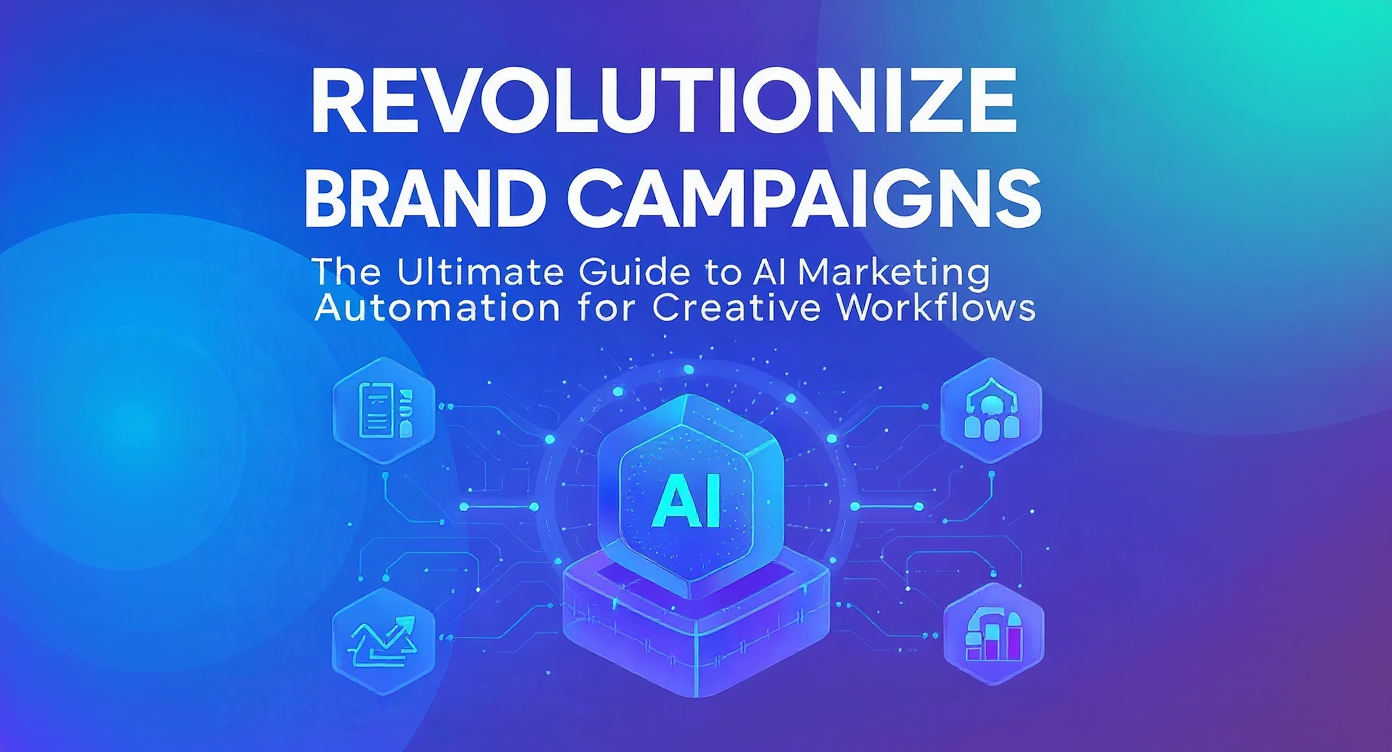Revolutionize Brand Campaigns: The Ultimate Guide to AI Marketing Automation for Creative Workflows

In today's algorithm-driven advertising landscape, creative relevance has become the new targeting. As platforms like Meta and LinkedIn shift away from granular audience targeting toward machine learning-based ad delivery, brands face an unprecedented challenge: How do you scale personalized, on-brand creative assets across thousands of micro-segments without overwhelming your team or sacrificing brand integrity?
The Evolution of Brand Campaign Management
Traditional campaign approaches are rapidly becoming obsolete. Single ad variants, manually built audiences, and limited personalization no longer deliver competitive results in modern digital advertising. Research shows that brands implementing creative personalization at scale see significant improvements in campaign performance compared to those using traditional methods, with personalized emails generating 29% higher open rates and 41% higher click-through rates.
The evolution has been dramatic:
Pre-2015: Manual creative production with limited variations
2015-2020: Template-based approaches with some automation
2020-Present: AI-driven creative production enabling thousands of personalized variants
Key Challenges in Creative Workflows
Before automation, creative teams faced numerous bottlenecks that limited campaign effectiveness:
Production Scalability: Creating hundreds of ad variations manually is virtually impossible for most teams.
Brand Consistency: Maintaining visual and messaging consistency across numerous assets is challenging.
Personalization Limitations: Without automation, deep personalization by location, audience segment, or intent is operationally unfeasible.
Approval Bottlenecks: Traditional approval workflows become overwhelmed when scaling creative production.
Performance Analysis: Tracking which creative elements drive performance becomes exponentially complex with scale.
Benefits of Automating Creative Workflows
Implementing AI marketing automation for creative workflows delivers transformative benefits:
Exponential Creative Scale
Automated creative workflows enable brands to produce thousands of personalized ad variants across multiple formats (image, video, carousel) while maintaining design consistency. This scale allows algorithms to learn faster and optimize delivery more effectively.
Creative as Targeting
Instead of relying solely on audience filters, automated workflows enable creative personalization that helps algorithms match your message to the right users. For example, creating variants like "Fresh Chicken in HSR Layout" or "Biryani for GenZ" allows platforms to find the perfect audience match.
SurgeGrowth's automated creative production platform enables brands to launch thousands of personalized, high-performing ad creatives efficiently and on-brand, making it ideal for this approach.
Operational Efficiency
Marketing automation significantly improves efficiency, with studies showing that automation helps streamline routine and complex marketing tasks. According to industry data, 58% of marketers use automation for routine work, freeing up substantial time for strategic activities.
Improved Campaign Performance
Companies using AI-driven personalization can reduce acquisition costs by up to 50% and increase revenues by 5-15%. Additionally, 89% of marketers observe a positive return on investment when using personalization in their campaigns, with improved customer retention and engagement cited as key outcomes.
Essential Components of an Automated Creative Workflow
A comprehensive automated creative workflow system includes:
Dynamic Creative Templates
Customizable templates form the foundation of scalable creative production. These templates should allow for rapid experimentation with messaging, visuals, and calls-to-action—perfect for A/B testing and localization efforts.
Content Management System
A centralized repository for brand assets, copy variations, and approved creative elements ensures consistency while enabling personalization.
Workflow Automation Tools
Automated approval processes, task management, and production scheduling eliminate bottlenecks and streamline collaboration.
Performance Analytics
Real-time feedback loops that track not just audience segments but creative styles, tone, and messaging effectiveness are essential for optimization.
Implementing Automation in Your Brand Campaigns
Successfully implementing creative workflow automation requires a strategic approach:
Audit Current Processes
Begin by mapping your existing creative workflow, identifying bottlenecks, and determining which elements would benefit most from automation.
Define Personalization Variables
Identify the key variables for personalization in your campaigns:
- Geographic locations
- Audience segments
- Product variants
- Seasonal messaging
- Behavioral triggers
Establish Brand Guidelines
Create clear parameters for automated variations to ensure brand consistency across all generated assets.
Select the Right Platform
Choose a platform like SurgeGrowth that combines automated creative workflows with human-quality outputs, making it easy to scale campaigns tailored to location, audience type, intent, or behavior.
Start Small, Then Scale
Begin with a single campaign type, perfect your approach, then expand to additional channels and campaign types.
Measuring Success and ROI
Track these key metrics to evaluate the impact of your automated creative workflow:
Production Efficiency: Time saved in creative production
Creative Volume: Number of variants produced and tested
Performance Metrics: CPA, CTR, and conversion improvements
Team Satisfaction: Reduced burnout and increased strategic focus
Brand Consistency Score: Measurement of brand guideline adherence
Future Trends in Creative Workflow Automation
The future of creative workflow automation is evolving rapidly:
Predictive Creative Optimization: AI systems that predict which creative elements will perform best before campaigns launch
Real-Time Creative Adaptation: Dynamic creative that adjusts based on real-time performance data
Cross-Channel Automation: Seamless adaptation of creative assets across multiple platforms and formats
Emotion-Driven Personalization: Creative variations based on emotional triggers and psychological profiles
Transform Your Brand Campaigns with SurgeGrowth
SurgeGrowth's AI creative production platform enables brands to launch thousands of personalized, high-performing ad creatives—fast, efficiently, and on-brand. By combining automated creative workflows with human-quality outputs, SurgeGrowth makes it easy to scale campaigns tailored to location, audience type, intent, or behavior.
With SurgeGrowth, you can:
- Deploy thousands of creatives rapidly
- Lower CPAs through improved creative relevance
- Maintain strong brand presence across all touchpoints
- Reduce manual work while increasing impact
In today's algorithm-driven advertising landscape, creative is the new targeting. Automated creative workflows are no longer optional—they're essential for brands seeking to compete effectively and scale their marketing efforts.
Frequently Asked Questions
How does creative workflow automation differ from traditional marketing automation?
While traditional marketing automation focuses on customer journey and email sequences, creative workflow automation specifically addresses the production, personalization, and optimization of visual and messaging assets at scale.
What types of campaigns benefit most from automated creative workflows?
Hyperlocal campaigns, product variant promotions, audience micro-segment targeting, and multi-channel brand campaigns see the greatest benefits from creative workflow automation.
How does automation improve marketing team efficiency?
Automation streamlines routine tasks, allowing marketing teams to focus on strategy and creative direction rather than repetitive production work. Studies show that 58% of marketers use automation for routine work, significantly improving productivity.
Does automating creative workflows reduce the need for creative professionals?
No, it actually enhances their impact by freeing them from repetitive tasks to focus on strategy, innovation, and creative direction.
How quickly can brands implement creative workflow automation?
With platforms like SurgeGrowth' Al tool, basic implementation can be completed in weeks, with full optimization typically achieved within 2-3 months.
Sources
- Litmus: State of Email Report
https://www.litmus.com/resources/state-of-email-20231
- HubSpot: State of Marketing Report
https://www.hubspot.com/state-of-marketing2
- AI in Marketing: Adoption and Performance Metrics
https://www.searchenginejournal.com/state-of-ai/3
- Instapage: Personalization Blog
https://instapage.com/blog/personalization/4
- Salesforce: State of Marketing Report
https://www.salesforce.com/eu/resources/research-reports/state-of-marketing


